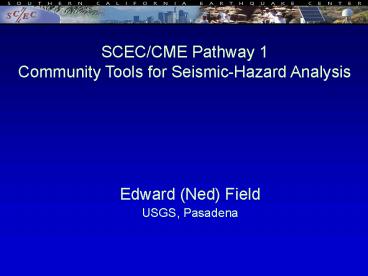Edward Ned Field - PowerPoint PPT Presentation
1 / 24
Title:
Edward Ned Field
Description:
... mean PGA of 14 g predicted for the Yucca Mt Repository) ... web/GUI enabled. Java (or wrapped code) Any IMR or ERF can be plugged in. SHA Models Implemented: ... – PowerPoint PPT presentation
Number of Views:51
Avg rating:3.0/5.0
Title: Edward Ned Field
1
SCEC/CME Pathway 1 Community Tools for
Seismic-Hazard Analysis
- Edward (Ned) Field
- USGS, Pasadena
2
Status of Seismic Hazard Analysis (SHA)
- SHA needs a more physics-based approach to
modeling. - Lack of consensus on how to construct more
physics based models means well have multiple
options. - All viable models need to be considered for
proper SHA (SSHAC Report, 1995). - given the above, SHA needs a computational
infrastructure capable of handling a potentially
great number of arbitrarily complex models - (a Community Modeling
Environment).
3
Why SHA needs more physics
Goal of Seismic Hazard Analysis
The probability that some
Intensity-Measure Type (e.g., PGA, SA) will
exceed a specified
Intensity-Measure Level (e.g., 0.5 g)
4
Why SHA needs more physics
Two main model components
5
Why SHA needs more physics
Two main model components
However, there is no consensus on how to build
these types of models.
Thus, SCEC has a working group (RELM) that is
developing a variety of viable physics-based
models.
6
Why SHA needs more physics
Two main model components
- Intensity-Measure
- Relationship
Gives shaking level for a given site and
fault-rupture event
Attenuation Relationships (traditional) (no
physics)
Lack of physics can lead to non-physical results
(e.g., a mean PGA of 14 g predicted for the Yucca
Mt Repository).
7
Why SHA needs more physics
Two main model components
- Intensity-Measure
- Relationship
Gives shaking level for a given site and
fault-rupture event
Potentially more accurate.
However, still developmental due to limited
structural knowledge and computational demands.
Pathway II is working on these issues.
8
Why SHA needs more physics
Two main model components
- Intensity-Measure
- Relationship
Gives shaking level for a given site and
fault-rupture event
For now, the NGA project is developing a
variety of these (no consensus here either).
Attenuation Relationships (traditional) (no
physics)
9
Status of Seismic Hazard Analysis (SHA)
- SHA needs a more physics-based approach to
modeling. - Lack of consensus on how to construct more
physics based models means well have multiple
options.
NGA
RELM
Pathway II
10
Status of Seismic Hazard Analysis (SHA)
- SHA needs a more physics-based approach to
modeling. - Lack of consensus on how to construct more
physics based models means well have multiple
options. - All viable models need to be considered for
proper SHA (SSHAC Report, 1995).
11
Status of Seismic Hazard Analysis (SHA)
- SHA needs a more physics-based approach to
modeling. - Lack of consensus on how to construct more
physics based models means well have multiple
options. - All viable models need to be considered for
proper SHA (SSHAC Report, 1995). - given the above, SHA needs a computational
infrastructure capable of handling a potentially
great number of arbitrarily complex models - (a Community Modeling
Environment).
12
OpenSHA
A framework where any arbitrarily complex (e.g.,
physics based) SHA component can plug in for
end-to-end SHA calculations.
- object oriented
- open source
- platform ind.
- web/GUI enabled
- Java (or wrapped code)
13
OpenSHA
SHA Models Implemented
Intensity-Measure Relationships (Attenuation
Relationships) Boore et al. (1997) Abrahamson
Silva (1997) Campbell (1997) Sadigh et al.
(1997) Field (2000) Abrahamson (2000) Campbell
Bazorgnia (2003) ShakeMap (2003)
Earthquake Rupture Forecasts PEER Fault PEER
Area PEER Non-Planar Fault PEER Listric
Fault PEER Multi-Source PEER Logic Tree USGS/CGS
(1996) STEP So. Cal. (2003) STEP Alaska Pipeline
(2003) WGCEP (2002)
14
OpenSHA
Applications Available
3) Hazard Map Data Calculator
15
How Has the ITR Collaboration Helped?
Issue 1 Who is going to host all these
physics-based models as well as the databases
they depend upon (especially since
revisions/updates are inevitable)?
Answer Developers will host their own models
and data resources as Web Services (enabling
run-time access over the internet).
16
How Has the ITR Collaboration Helped?
Presently Implemented Web Services
- Community Velocity Model (for setting site types)
- GMT Mapping Service (for making hazard maps)
- Earthquake Rupture Forecasts
- USGS/CGS 1996 Forecast
- STEP So. Cal. Forecast
- WGCEP-2002 Forecast (as wrapped Fortran Code)
17
How Has the ITR Collaboration Helped?
Web Services make our applications lightweight
platform independent (e.g., users dont have to
install GMT)
Web Services put the maintenance onus directly on
the host.
18
How Has the ITR Collaboration Helped?
Issue 2 Hazard map calculations typically take
several hours for just one set of models, but
proper SHA requires that we explore all
possible model combinations (or all parameter
settings within a model).
Answer GRID computing. (Show figure here
??????????)
19
How Has the ITR Collaboration Helped?
Issue 3 How can we archive the huge volumes of
data generated by the hazard-map calculations (we
need to save computations that are particularly
time consuming)?
Answer Digital Library Technologies (work in
progress).
20
How Has the ITR Collaboration Helped?
Issue 4 As the number of models and databases
available in the CME grows, how will we keep
track of them all (and their relationships to
each other)?
Answer Knowledge Representation Reasoning
(KRR)?
21
How Has the ITR Collaboration Helped?
Issue 5 How does a developer make their model
or database known to the community modeling
environment?
Answer Knowledge Representation Reasoning
(KRR)?
22
OpenSHASCEC ITR CollaborationCME for SHA
In Summary
23
Computational Pathways
Pathway 1 Standard Seismic Hazard Analysis
24
OpenSHA
Pathway 1































